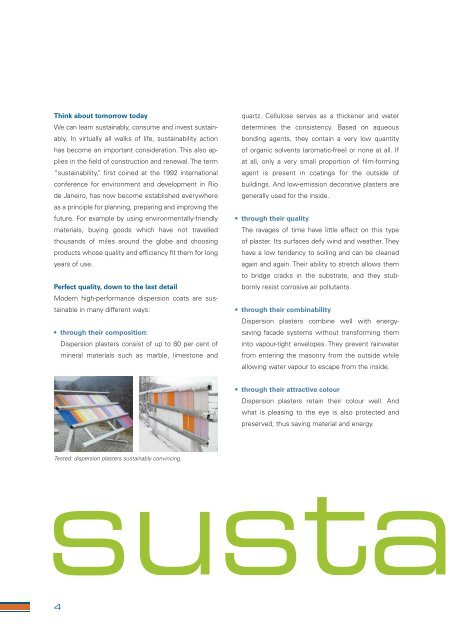Ready-to-use render for facades and interiors
Create successful ePaper yourself
Turn your PDF publications into a flip-book with our unique Google optimized e-Paper software.
Think about <strong>to</strong>morrow <strong>to</strong>day<br />
We can learn sustainably, consume <strong>and</strong> invest sustainably.<br />
In virtually all walks of life, sustainability action<br />
has become an important consideration. This also applies<br />
in the field of construction <strong>and</strong> renewal. The term<br />
“sustainability,” first coined at the 1992 international<br />
conference <strong>for</strong> environment <strong>and</strong> development in Rio<br />
de Janeiro, has now become established everywhere<br />
as a principle <strong>for</strong> planning, preparing <strong>and</strong> improving the<br />
future. For example by using environmentally-friendly<br />
materials, buying goods which have not travelled<br />
thous<strong>and</strong>s of miles around the globe <strong>and</strong> choosing<br />
products whose quality <strong>and</strong> efficiency fit them <strong>for</strong> long<br />
years of <strong>use</strong>.<br />
Perfect quality, down <strong>to</strong> the last detail<br />
Modern high-per<strong>for</strong>mance dispersion coats are sustainable<br />
in many different ways:<br />
• through their composition:<br />
Dispersion plasters consist of up <strong>to</strong> 80 per cent of<br />
mineral materials such as marble, limes<strong>to</strong>ne <strong>and</strong><br />
quartz. Cellulose serves as a thickener <strong>and</strong> water<br />
determines the consistency. Based on aqueous<br />
bonding agents, they contain a very low quantity<br />
of organic solvents (aromatic-free) or none at all. If<br />
at all, only a very small proportion of film-<strong>for</strong>ming<br />
agent is present in coatings <strong>for</strong> the outside of<br />
buildings. And low-emission decorative plasters are<br />
generally <strong>use</strong>d <strong>for</strong> the inside.<br />
• through their quality<br />
The ravages of time have little effect on this type<br />
of plaster. Its surfaces defy wind <strong>and</strong> weather. They<br />
have a low tendency <strong>to</strong> soiling <strong>and</strong> can be cleaned<br />
again <strong>and</strong> again. Their ability <strong>to</strong> stretch allows them<br />
<strong>to</strong> bridge cracks in the substrate, <strong>and</strong> they stubbornly<br />
resist corrosive air pollutants.<br />
• through their combinability<br />
Dispersion plasters combine well with energysaving<br />
facade systems without trans<strong>for</strong>ming them<br />
in<strong>to</strong> vapour-tight envelopes. They prevent rainwater<br />
from entering the masonry from the outside while<br />
allowing water vapour <strong>to</strong> escape from the inside.<br />
• through their attractive colour<br />
Dispersion plasters retain their colour well. And<br />
what is pleasing <strong>to</strong> the eye is also protected <strong>and</strong><br />
preserved, thus saving material <strong>and</strong> energy.<br />
Tested: dispersion plasters sustainably convincing.<br />
susta<br />
4


